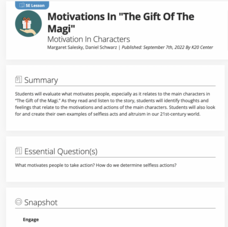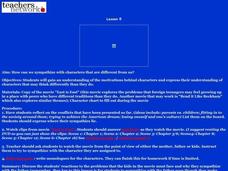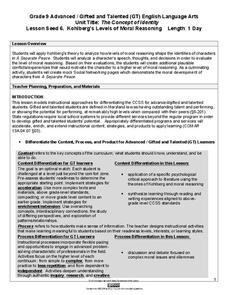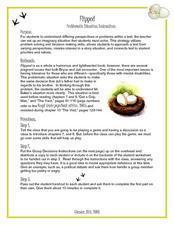K20 LEARN
Criminal Motivations: Irony and Characterization In "The Cask Of Amontillado"
Edgar Allan Poe's short story "The Cask of Amontillado" is a bit of a puzzle. Critics have long debated Montresor's motives for killing Fortunato. Young scholars examine examples of the three types of irony (verbal, dramatic, and...
Curated OER
Character Development: Cancer - A New Treatment
Learners explore the concept of character development. In this character development lesson, students watch a video segment regarding a family's struggle with cancer. Learners examine the personality, situation, motivation, and actions...
K20 LEARN
Motivations In "The Gift Of The Magi": Motivation In Characters
O. Henry's short story, "The Give of the Magi," launches a study of what motivates people to act as they do. Class members identify what they believe are the motivations of the characters in O. Henry's tale and then craft a one-page...
Curated OER
A Boxful of Character
I can't wait to try this activity with my class. It's versatile and could be modified to fit any character analysis lesson. To analyze characters thoroughly, learners create life boxes. Each box will pertain to a character from any...
K20 LEARN
"The Interlopers": Are You Ready to Rumble? Conflict, Motivation, and Setting
Capulets and Montagues. Sharks and Jets. Nortenos and Surenos. Gradwitzes and Znaeyms? Hector Hugh Munro's short story "The Interlopers" invites high schoolers to consider the causes of conflicts and reflect on what it takes to resolve...
Orange County Department of Education
The Glass Slipper Shatters
High school freshmen craft their own definition of honesty. They provide an example from their lives and reflect on the outcomes of their honest behavior. They also identify a time when they may have been dishonest in a relationship and...
Maryland Department of Education
The Concept of Identity Lesson 5: Motivation - Maslow's Hierarchy of Needs
Maslow's Hierarchy of Needs provides the lens class members use to analyze and evaluate the motivations of the characters in Sylvia Plath's "Initiation" and scenes from Mean Girls. Readers then select a character from A Separate...
Shakespeare Globe Trust
Macbeth
Why do characters do what they do? Scholars use the resource to explore character motivation in Shakespeare's tragedy Macbeth. Additionally, they discover pictures, interviews, and videos from the Deutsche Bank production of the play.
Curated OER
The Cask of Amontillado
Learners examine the Edgar Allan Poe story "The Cask of Amontillado." In this character lesson, students discuss and analyze the characters in the story. Learners make personal connections to the characters and create a brochure...
Curated OER
The News Behind the Story
What a fun way to analyze plot, setting, and character. Learners review story elements, read a short fictional story, then turn the events of that story into a headlining news paper article. Not only does this lesson engage critical...
Curated OER
Lesson 8: Prithee, Pause!
High school learners examine primary source materials on history and the supernatural which relate to Julius Caesar. They then act out a scene based on different historical understandings and identify facts, theories, and similarities in...
Great Books Foundation
The Glass of Milk
It's not easy to ask for help. Learn why a boy on a ship struggles with accepting help in "The Glass of Milk," a short story by Manuel Rojas. Six discussion questions prompt class members to make inferences from the text about character...
Curated OER
Character Analysis
Learners analyze the motivations behind characters. In this character analysis lesson, students reflect on conflicts from previous stories and watch a clip from 'East is East.' Learners answer questions for the movie and watch the movie...
Shakespeare Globe Trust
Much Ado About Nothing
Love, deception, witty bante—that's much ado about a lot! As learners navigate the resource, they view an interactive character map and read character biographies from Shakespeare's Much Ado About Nothing. Pupils also listen to...
Curated OER
SATs, Shakespeare Paper
By using PEE (Point, Evidence, Explanation) exam takers will be taken through a study guide on Shakespeare test questions. Character motivation, analysis of text, ideas, themes, and issues will all be covered in this "how to" answer SAT...
Curated OER
Shizuko’s Daughter: Discussion Web
Is Yuki a selfish character? Analyze her motivation and behavior during a unit on Shizuko's Daughter by Kyoko Mori. Readers fill out two sides of a graphic organizer with reasons why or why not she is selfish, and then come up with a...
Simon & Schuster
Curriculum Guide to: A Tale of Two Cities by Charles Dickens
A Tale of Two Cities is the core text for five lessons in a Curriculum Guide for Charles Dickens' famous novel. To begin, scholars examine Dickens' use of anaphora in the first line of the novel. Next, they compare the point of view in a...
Penguin Books
A Teacher's Guide to the Signet Classics Edition of William Shakespeare's The Merchant of Venice
It's a wise teacher who knows their pupils well enough to tackle using The Merchant of Venice as a whole-class reading. This 40-page teaching guide may not glitter but is filled with nuggets that will prove invaluable to those new to...
Novelinks
The Crucible: Questioning Strategies Bloom's Taxonomy
Enrich your unit on Arthur Miller's The Crucible with a list of reading questions based on Bloom's Taxonomy. Kids answer questions and provide context for the knowledge, comprehension, application, analysis, synthesis, and evaluation...
Waunakee Community School District
Identifying Themes in Literature
If your language arts learners have a hard time determining the universal theme of a written work, use a straightforward learning exercise to help them find it. After reviewing a list of common themes, kids note the title, character,...
Maryland Department of Education
The Concept of Identity Lesson 6: Kohlberg's Levels of Moral Reasoning
How does our moral reasoning shape our identity? After a study of Kohlberg's Levels of Moral Reasoning, readers use Kohlberg's theories to analyze the speech, thoughts, and decisions of a character in A Separate Peace. They then create...
Novelinks
Wuthering Heights: Unsent Letters
To demonstrate their understand of the characters in Wuthering Heights and their motivations, readers assume the identity of one of the characters and write a letter to another character in the Bronte's novel.
Avi Writer
Sophia’s War: A Tale of the Revolution Teaching Guide
Sophia's War, Avi's novel that tracks the adventures of Sophia Calderwood, a fictional character, as well as the true stories of British Major John Andre and General Benedict Arnold during the American Revolution, is the anchor text of...
Brigham Young University
Flipped: Problematic Situations
An activity based on the young adult novel Flipped, groups work to make the same difficult decision a character in the novel faces. Each group is given the same scenario about caring for a mentally disabled brother personally or putting...

























